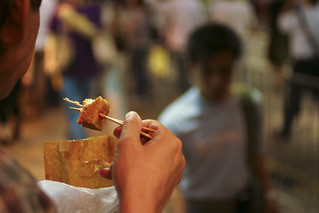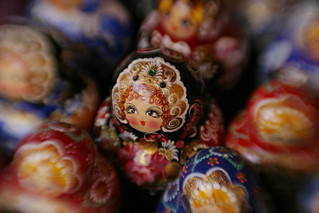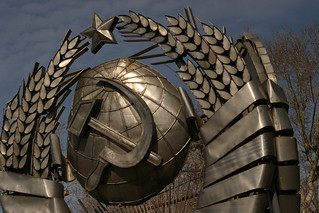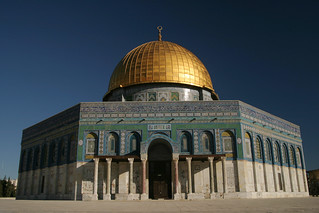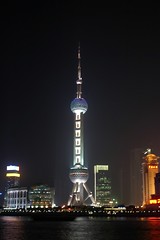
Five days in Shanghai is too much –unless you’ve got family or friends to visit, business to conduct or serious shopping to do. There is not much for the Lonely Planet toting backpacker. A few small pockets of the China all westerners long to see –tea houses, pagodas, temples and beautiful gardens. Most of Shanghai is filled with modern high rises –a testament to the waking dragon’s economic powers– spotted between older communist building projects, many now little more than slums. Here and there you can still see a bit of the past.
The Bund [wikipedia.org] is still lined with western buildings in ‘Romanesque, Gothic, Renaissance, Baroque, Neo-Classical, Beaux Arts, and Art Deco’ styles –if you are an architecture lover it’s worth the visit. Filled with western tourists and business men it’s not that interesting, but good for it’s reverse culture shock –you feel like you’re in London more than Shanghai, until the hawkers spot you– and it’s bars and pubs. The night life is alive and well along the Bund so if you’re up for some partying; have at.
I stayed in a small hotel on the southwest side of Shanghai. My room was on the third floor over looking a small but busy street. I had a large window to look out on the city. The view was not beautiful; smog was constant and construction was omnipresent. Highrise cranes filled the skyline, almost as common as telephone poles. From my little hotel room I explored the local neighborhoods for at least a few hours every day. One of the first things that was obvious was the juxtaposition of housing. In a few blocks you might pass a 20+ story modern western style apartment block, a multi-story dilapidated communist housing unit, and older low level concrete housing which amounts today to little more then rubble and ruins.
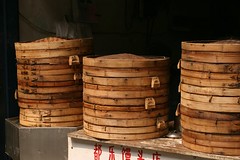
The people who lived among the ruins seem to be the major entrepreneurs of the city selling anything you want; food, drinks, clothing, bikes, parts, you name it. There was a lot of great street food and these vendors seemed to be the most friendly of the people I met in China on this trip. They would yell ‘hello’ and wave me over to see what they had. Pointing out what I could buy in broken English. The most persistent at this were the pirate DVD vendors –which appeared every night when the sun went down and were as common as bikes. There was at least 2 or 3 guys selling DVDs on every block.
China says it is doing all it can to tackle the piracy industry, but I don’t buy it. A few hundred cases and few hundred arrests? In one night a few hundred police in Shanghai could increase that number by at least an order or magnitude. On the other hand given the booming business that these pirated DVDs (and other goods) do I expect that if China really cracked down on this industry –even only enough to drive it truly underground as opposed to the current in-plain-sight state– the economy might grind to a halt causing a major problem. The only thing is the communists can’t admit that publicly, they can’t say “we are not in a position to stop the street vendors, it’s too much of a risk, the problem is too big, it could cause a major recession. Instead we are going to go after the root of the problem; the factories, the sweat shops and the organized crime. Thereby driving the street vendors away from the piracy industry in a more orderly fashion preventing any major negative economic consequences.” Oh well, the Party is never wrong I suppose. Piracy is, and I suspect will remain for some time, an endemic problem in China’s big cities.
After a couple of days in the concrete jungle of Shanghai I decided to head out of the city for a day trip. After looking over the options presented in the guide book I decide to head to Hangzhou [wikipedia.org] to see the famous West Lake [wikipedia.org]. This turned into a nightmare. First I got up at 5:30 in the morning to get ready and head to the train station –a 45 minute journey from my hotel by Metro/walking– as the first train passing through both Shanghai and Hangshou departed at 7:00. Once there I was confronted with the utter and complete chaos of the ticketing system. Twenty or so windows server tickets at the Shanghai railway station but not a one had anything resembling a line at it. Instead it was a push, shove, kick, and scream your way to the front and then do whatever you can to get the attention of the ticket seller; yell, shove money under the window, knock on the window. Do whatever you can. Chinese have no concept of a queue, twice now –in Beijing and in Shanghai– I have witnessed this lack of basic common sense and twice I have been utterly defeated by it.
After battling my way to the ‘English speaking’ counter it closed. Right in front of me. So I had to battle my way to another counter. Where I said ‘Ye. Hangzhou’ which means (kinda) ‘One. Hangzhou.’ The attendant looked at me. Typed something. Shook her head. Typed something else. Shook her head. Typed once more. Shook her head and looked at me saying ‘Bu’ which means ‘no.’ Then she pointed back down the row of windows and said ‘Engahrish.’ So I dodged and weaved my way back towards the only English speaking window in the station. By now it was 7:00. Missed that train.
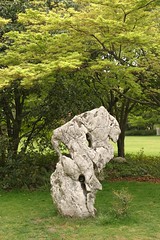
Meanwhile at the English speaking window the old haggard looking woman who had closed the window in my face had been replaced by a young fresh lady with a big smile. After swatting away several hands full of money belonging to others trying to get tickets while I was at the window I managed to tell her I wanted to go to Hangzhou.
“No tickets for 7, no tickets for 8:30. Standing room only for the 11:30. You want,” she asked.
‘Shit, there goes my day,’ I thought, “yes,” I said, “and return tonight?”
“Only 5 PM. Standing room.”
“Um. Ok.” ‘It’s a two hour trip so I’ll still have 4 hours or so’ I thought.
At least the tickets were cheep. I think I paid like US$3 in total. And I got exactly what I paid for… The train to Hangzhou was close to an hour late leaving Shanghai and was two hours of smoke between-the-cars and two-feet-from the nasty squatter toilet hell.
So by the time I got to Hangzhou it was 2:30. Then I had to take a cab to the shores of the actual West Lake… 30 minutes. This means I only had about an hour and 15 minutes to walk around the impressive and large West Lake –the lake the grounds of the Summer Palace [wikipedia.org] outside Beijing are based on– if I wanted to safely make it back to the train station, just in case my train was on time.
The whole reason I went to Hangzhou over some of the other sites in the guide book was to see the ‘ten attractions’ noted by the Emperor Qianlong: Spring Dawn on the Su Causeway (苏堤春晓), Listining Orioles Singing in the Willows (柳浪闻莺), View Fish in the Flower Harbour (花港观鱼),Lotus in the Breeze at the Winding Courtyard (曲苑风荷),Evening Bells at the Nanping Mountain (南屏晚钟),Autumn Moon over a Calm Lake (平湖秋月),Evening Sunshine over Leifeng Pagoda (雷峰夕照),Three Pools Mirroring the Moon (三潭印月), Melting Snow on Broken Bridge (断桥残雪), Twin Peaks Piercing the Clouds (双峰插云). Of which I managed to see exactly none.
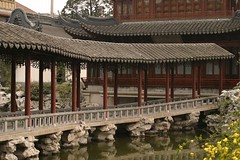
And then back to the train station for another late train and two more hours of stale smoke and shit smells. West Lake was beautiful and very peaceful if a little too much over ‘turistified’ by official renovations to exploit the tourists. But overall I’d say my trip was a waste of a day. The lesson of all this: make your ticket reservations days in advance.
That was about the end of my running around. I had an afternoon flight on Sunday so I did a little shopping and tried to get a good day time photo of the Bund and Pudong skyline (failed, too much smog.) Then a very long ride to the airport and a relaxing Singapore Airlines flight back to the clean, orderly, non-chaos of Singapore. Yes the nanny state has it’s great advantages.


